Understanding Diamond Clarity: A Comprehensive Guide
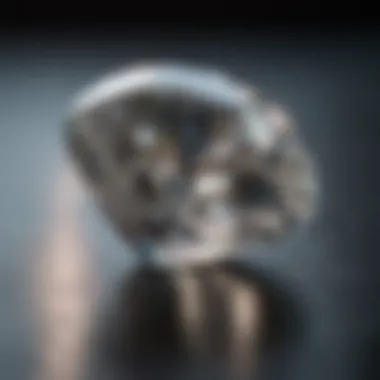
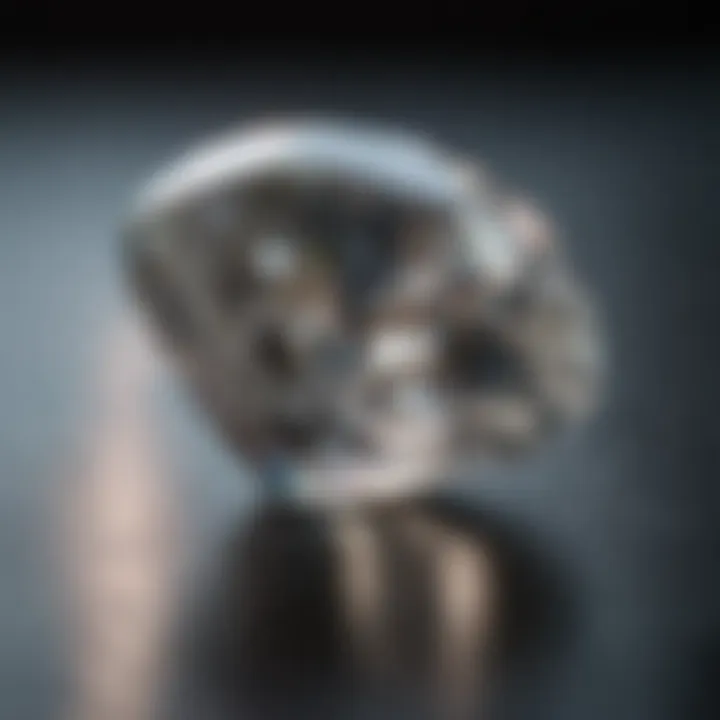
Intro
When diving into the fascinating world of diamonds, clarity emerges as a central concept. You might wonder, what exactly does clarity mean? At its core, diamond clarity refers to the presence and visibility of internal inclusions or external blemishes. These imperfections play a significant role in determining both the beauty and value of a diamond. Mastering the understanding of clarity is not just for gem enthusiasts but also for jewelers and collectors who wish to invest wisely.
As we embark on this exploration, it’s essential to recognize that clarity isn't merely a technical specification; it’s intertwined with an emotional narrative. After all, a diamond often embodies more than just a stone — it serves as a symbol of love, commitment, or achievement.
As we venture deeper into this guide, we’ll discuss various clarity grades and the implications they carry. We’ll also decode common inclusions and blemishes, uncover the nuances in the grading system, and consider synthetic diamonds that are increasingly becoming part of this rich tapestry. Together, let’s navigate the shimmering yet intricate landscape of diamond clarity.
Gemstone Overview
Definition and Characteristics
Diamonds belong to the broader category of gemstones, which are essentially minerals or organic materials that possess beauty and durability. A gemstone, by definition, is any precious or semi-precious stone used in jewelry and adornments. Diamonds have unique characteristics that distinguish them from other gemstones. They are the hardest known natural material, capable of cutting through almost anything, which makes them highly prized.
Moreover, their ability to refract light creates an unparalleled brilliance. This optical phenomenon is one reason why diamonds are often synonymous with luxury and value. Their allure lies not just in their physical properties but also in the rich symbolism attached to them.
Classification of Gemstones
The classification of gemstones can get a bit muddy, but it generally follows a hierarchy based on hardness, beauty, rarity, and value. To make sense of this vast categorization, stones are often divided into two main groups:
- Precious Stones: Typically includes diamonds, rubies, sapphires, and emeralds. These are highly sought after due to their rarity and desirable qualities.
- Semi-Precious Stones: These encompass a broader range, such as garnets, amethysts, and citrine. While less rare, they are nonetheless beautiful and often used in jewelry.
It's also worth noting that diamonds are, in their own right, classified into various types based on their origin — natural, synthetic, and enhanced. Each classification has implications for clarity and overall value.
Properties of Gemstones
Physical Properties
Each gemstone possesses unique physical properties that contribute to its overall charm. Hardness is crucial; diamonds rank a 10 on the Mohs scale, indicating they are tough as nails. Other physical properties include:
- Luster: This refers to how light interacts with the surface of the stone, with diamonds exhibiting a sparkling brilliance.
- Color: While many associate diamonds with a clear or white appearance, they can also come in a variety of colors — a rare blue or the striking pink, for instance.
Chemical Properties
Diamonds' chemical composition further enriches their mystique. They are primarily made of carbon atoms arranged in a crystal structure, which gives them their fantastic hardness and light-reflecting ability. Additionally, trace elements can introduce a spectrum of colors, adding yet another layer to their desirability. Understanding these chemical properties helps enthusiasts and collectors make informed decisions, especially when analyzing clarity.
"A diamond's clarity isn't just a number; it's a reflection of its journey, a story etched in every facet."
As we navigate the various nuances of diamond clarity, it's vital to grasp these foundational aspects of gemstones. With each step, we'll draw closer to understanding not just the technicalities of clarity grades but also its broader implications in the world of gemology.
Overview of Diamond Clarity
Diamond clarity is a cornerstone concept in the field of gemology, serving as a vital touchstone for evaluating a diamond's quality. It's not simply about how pretty a stone looks in the ring; it delves into the characteristics that underlie its beauty. By grasping the nuances of diamond clarity, buyers and enthusiasts can better appreciate the gem's value and desirability.
At its core, clarity refers to the presence of imperfections, or inclusions, within a diamond. These may be formed during the diamond's creation in the depths of the earth. Understanding diamond clarity equips consumers with essential knowledge for assessing the quality of their selections. Moreover, it opens the door to a deeper understanding of how these imperfections influence both aesthetics and price.
Definition of Diamond Clarity
In simple terms, diamond clarity describes the degree to which a diamond is free from internal or external flaws. This metric accounts for inclusions—tiny, often microscopic characteristics embedded within the diamond—and blemishes, which are surface-related imperfections. Just as each person has unique traits, every diamond carries distinct characteristics within its crystalline structure.
A diamond with high clarity is scarcier and typically more valuable. It reflects more light beautifully and sparkles more brilliantly than one with noticeable flaws. However, beauty is in the eye of the beholder. Some may prefer stones with visible inclusions for their unique stories, while others may lean toward perfection. Understanding one's preferences is crucial when considering clarity as a fundamental aspect of purchasing a diamond.
Importance in the Diamond Grading System
The diamond grading system is a well-structured framework that combines clarity with three other major factors: cut, color, and carat weight. Collectively known as the Four Cs, these elements work harmoniously to form a comprehensive assessment of a diamond's overall quality.
Clarity plays an important role in how a diamond is graded. For instance, two diamonds of equal carat weight may shine differently based on their clarity grades. Consequently, the inclusion of even minor flaws could mean one diamond falls short in grading compared to its flawless counterpart of similar size.
"Understanding clarity isn’t just a detail; it’s a passport to discerning the beautiful differences that make a diamond one of a kind."
The clarity grade can also directly influence market prices. A diamond graded as "Flawless" will command a higher price than one classified as "Included," reflecting consumer demand and the rarity of superior clarity. It becomes clear that clarity not just stands out for aesthetic reasons but also affects an owner's investment.
In wrapping this up, diving into the subject of clarity yields advantages that are useful for any collector or buyer. It's not merely a checkbox on a grading sheet; it's an enlightening journey into the art of diamond evaluation. In the following sections, we will explore the Four Cs and give a detailed look at clarity grades, further assisting our readers in navigating the complex world of diamond selection.
The Four Cs of Diamonds
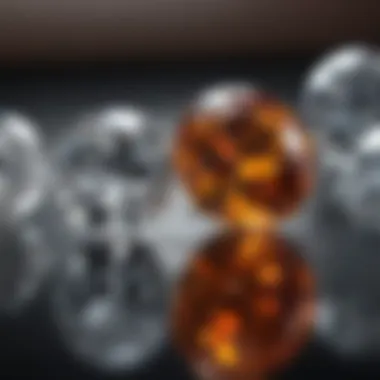
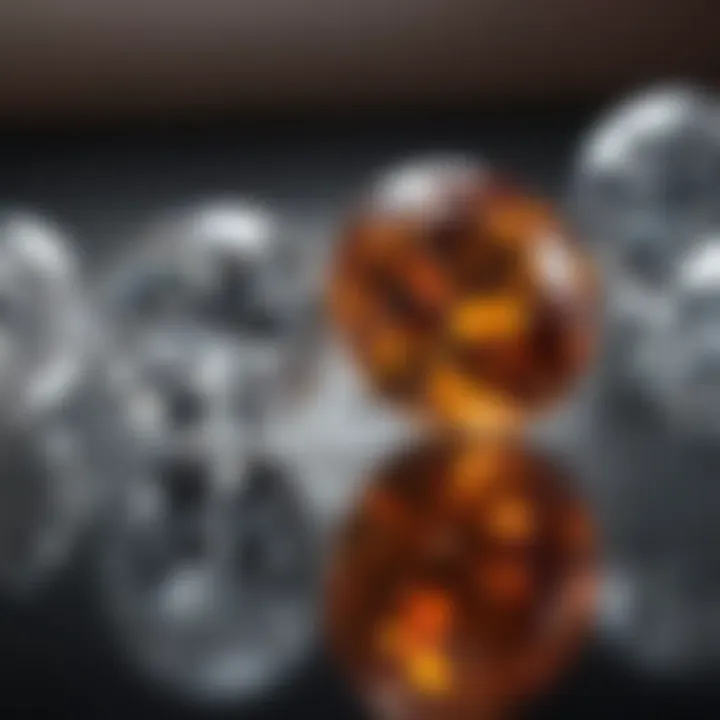
The concept of the Four Cs in diamonds—cut, color, clarity, and carat weight—serves as the cornerstone for determining the quality and desirability of a diamond. Each element plays a critical role, shaping not only the visual appeal but also the overall value of the gem. A keen understanding of these four aspects enables buyers to make informed choices while navigating the often overwhelming world of diamonds. Moreover, mastering this matrix can elevate one from a mere spectator to a discerning connoisseur, capable of recognizing the unique narrative each diamond tells.
An Prelude to the Four Cs
When discussing diamonds, the Four Cs stand out as a fundamental Rubik's Cube that can perplex even seasoned enthusiasts.
- Cut: This pertains to how a diamond is shaped and faceted, significantly impacting its brilliance and reflectivity. It's not merely about the shape, such as round or princess; the quality of the cut influences light performance directly.
- Color: Diamonds are not devoid of color; rather, they come in a spectrum from colorless to shades of yellow or brown. A finer diamond is typically colorless, allowing more light to pass through, enhancing its brilliance.
- Clarity: This focuses on the presence of inclusions and blemishes, which can detract from a diamond's optical clarity. Diamonds with fewer imperfections are considered more precious.
- Carat Weight: This refers to the weight of the diamond. Heavier stones are generally rarer and can command higher prices, though this also intertwines with the other Cs.
Understanding these components can make the diamond purchasing process less daunting. It helps frame expectations and guides the buyer toward what they truly value, whether that be supreme brilliance or a larger carat.
Relationship Between Cut, Color, Clarity, and Carat Weight
The Four Cs do not exist in silos; they interact in intricate ways, creating a network of relationships that directly affect a diamond's value.
- Interdependence: A superior cut can enhance the color and clarity perceptions of a diamond. Even a lower color grade might sparkle beautifully if cut skillfully, drawing the eye and overshadowing the color defect. Conversely, a poorly cut, high-color diamond may appear lackluster, failing to reflect its true worth.
- Balancing Act: Many buyers find themselves torn between these elements. For instance, one might yearn for a larger carat diamond but realize the compromise in clarity or color. This requires a thoughtful balance. Prioritize what matters most to you: Is it size, visual appeal, or perhaps, rarity in clarity?
- Market Trends: Market preferences can sway importance among the Four Cs. Currently, some collectors lean towards color and clarity, seeking stones that are both visually stunning and rare. Others may focus solely on carat weight, equating size with value.
In essence, understanding how these aspects interplay helps buyers navigate their choices more effectively, guiding them to a diamond that resonates with their aesthetic and financial considerations.
*"When you layer the Four Cs thoughtfully, you don’t just select a diamond; you embrace its narrative—one of beauty, rarity, and personal significance."
By grasping these nuances, anyone from a budding collector to a seasoned jeweler can approach diamond purchases with clarity—pun intended.
Clarity Grades Explained
Understanding diamond clarity grades is pivotal for anyone stepping into the realm of gemstones. Clarity grades dictate not only a diamond's visual allure but also its value in the marketplace. A diamond's clarity grade is an assessment of the presence, size, and visibility of internal and external flaws. These imperfections can be as minute as a speck of dust or as noticeable as a large inclusion.
Evaluating clarity helps buyers make informed decisions when purchasing a diamond, as each grade has its particular traits and implications for desirability.
Understanding the Grading Scale
The grading scale serves as the backbone of clarity assessment. Diamonds are typically graded on a scale from Flawless to Included. The Gemological Institute of America (GIA) is among the most reputable organizations that establish these standards:
- Flawless (F): No inclusions or blemishes visible under 10x magnification.
- Internally Flawless (IF): No internal inclusions visible under 10x magnification, may have surface blemishes.
- Very Slightly Included (VVS1 and VVS2): Inclusions are very difficult to detect under 10x magnification.
- Slightly Included (SI1 and SI2): Inclusions that are noticeable under 10x but usually not visible to the naked eye.
- Included (I1, I2, I3): Inclusions obvious under 10x magnification and often visible without magnification.
Each grade in this scale provides a clearer visual reference and serves as a crucial element in determining the value of the diamond.
What Each Clarity Grade Indicates
Each clarity grade brings with it not just a name, but a narrative woven into the diamond's journey.
- Flawless Diamonds: These are like rare gems that not every collector encounters. Their reflection and brilliance are often unparalleled, making them highly desirable.
- Internally Flawless Diamonds: While outer blemishes may exist, the inner beauty remains intact. They offer a sweet compromise between availability and luxury.
- Very Slightly Included Diamonds: A choice for those searching for high-quality stones while considering budget constraints. Their minor inclusions are almost invisible, keeping the diamond elegant.
- Slightly Included Diamonds: These diamonds present a balance of beauty and value, with inclusions sometimes viewable from a slight distance.
- Included Diamonds: Bore the most visible flaws, often leading to lower value. However, they can still charm collectors who appreciate the unique histories behind each imperfection.
In essence, understanding what each grade indicates shapes not just a buyer’s choice, but also personal stories and memories that bind us uniquely to our pieces.
Comparison of Clarity Grades
When it comes to comparing clarity grades, it helps to keep a few things in mind to find the diamond that feels just right.
- Price Variation: Generally, the higher the clarity, the steeper the price. Flawless diamonds can command astonishing sums, while included ones offer budget-friendly options.
- Aesthetic Considerations: A VVS or IF diamond will shine more brilliantly, often appearing more lustrous compared to a lower-graded stone, yet a well-cut SI stone may still dazzle the eye at first glance.
- Personal Preference: Some collectors may purposely seek out inclusions for character; a diamond with a fascinating inclusion can often generate a captivating story.
It’s crucial to remember that clarity does not solely dictate desirability. Emotional connections and personal stories tied to the diamond could weigh even heavier in an individual's decision-making process.
By analyzing and understanding the differences between these clarity grades, buyers can navigate the diamond market with greater wisdom, finding the perfect blend of beauty, authenticity, and personal resonance.
Types of Inclusions and Blemishes
When delving into the world of diamonds, understanding types of inclusions and blemishes is imperative. These characteristics greatly influence the clarity grade of a diamond, which in turn affects its beauty and value. Inclusions are internal flaws, while blemishes are external imperfections; both can alter the appearance of a diamond significantly. By learning about these imperfections, one can better appreciate the nuances of diamond quality and what sets one stone apart from another.
Common Inclusions Found in Diamonds
Inclusions come in various forms, and knowing them can be pivotal for making informed decisions. Some of the most frequently encountered types include:
- Feathers: These are subtle, wispy lines that resemble feathers. They form when the diamond undergoes pressure and can sometimes affect clarity, especially if they reach the surface.
- Clouds: A cluster of tiny, pinpoint inclusions can create a hazy effect, diminishing a diamond's clarity.
- Crystals: Small crystals of different minerals can become trapped within a diamond, leaving sparkling little flares that some collectors find fascinating.
- Knot: A crystal inclusion that extends to the surface, it can significantly impact durability and the diamond's grading.
These inclusions serve as a fingerprint for the diamond, but be mindful; they can either enhance or detract from the overall appearance. A single, well-placed inclusion might not harm beauty, while a cloud of tiny imperfections can create an undesirable look.
Types of Blemishes That Affect Clarity
Blemishes, on the other hand, are surface-level imperfections that can happen during the diamond's journey before it reaches the jeweler. Some typical blemishes include:
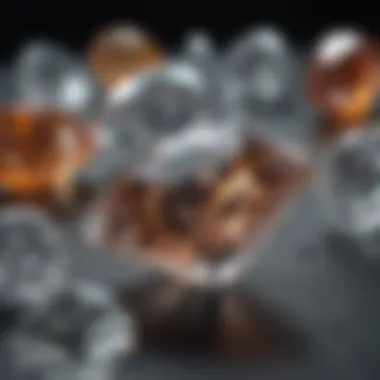
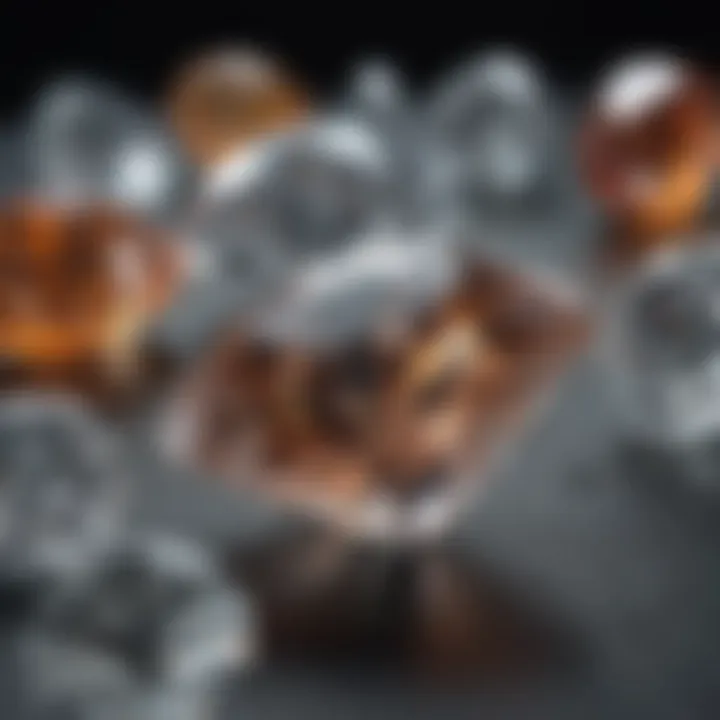
- Scratches: Simple to identify, scratches can form on the stone during handling or setting, impacting its shine.
- Nicks: Tiny chips along the edges might be minuscule but can have serious implications for the diamond’s overall durability.
- Polish Lines: Often a result of the polishing process, these fine lines can reveal themselves upon close inspection and may affect perception of clarity.
- Bearding: This is a fringe-like appearance found along the girdle, often a result of the diamond's cutting process; while not as common, it can affect visual appeal.
Understanding these blemishes is crucial as they can affect the shiny brilliance one expects from a diamond. While some blemishes may fall unnoticed under standard viewing conditions, they can significantly impact the market value.
"Inclusory characteristics in diamonds are not merely imperfections; they tell a story of the diamond's formation, character, and journey."
Impact of Clarity on Appearance
When it comes to the allure of diamonds, clarity plays a pivotal role that is often overlooked. Many individuals might focus on cut or carat weight, but without a discerning eye on clarity, one may miss the finer details that contribute to a diamond's overall charm and luminosity. In this section, we will explore how clarity affects a diamond's appearance, weaving together aspects of light interaction and the visual nuances that distinguish one clarity grade from another.
How Clarity Affects Light Interaction
The sparkle and fire of a diamond are directly influenced by how well light passes through it. Clarity determines the presence and visibility of inclusions—tiny imperfections within the stone. When light strikes a diamond, the way it is refracted and reflected can create stunning light displays or, conversely, dull appearances if clarity is compromised.
Consider this: a diamond rated as "Flawless" will typically exhibit exceptional brilliance. Light travels freely through it, breaking into colors and producing that enchanting sparkle that draws people in. On the other hand, a diamond with notable inclusions may scatter light in unpredictable ways, leading to a less lively and more subdued effect. This inefficiency in light passage can cause the diamond to appear less vibrant, making it crucial for buyers to consider clarity when evaluating or purchasing.
Visual Differences Between Clarity Grades
When comparing clarity grades, the visual differences can be quite striking. A quick overview can illuminate how these variations manifest:
- Flawless (F): No inclusions visible under 10x magnification. This type of diamond truly shines, appearing almost otherworldly.
- Internally Flawless (IF): Minor surface blemishes may be present, but inclusions are invisible. The visual appeal remains incredibly high.
- Very Slightly Included (VSI1 & VSI2): Inclusions are very difficult to see without magnification. The diamond retains a brilliant appearance, appealing to many.
- Slightly Included (SI1 & SI2): Inclusions are noticeable under 10x magnification and may slightly impact light reflection.
- Included (I1, I2, & I3): Inclusions are visible to the naked eye. This is where clarity significantly reduces the overall aesthetic quality, affecting desirability.
"Clarity not only influences the diamond's visual beauty but also feeds into the emotional connection of ownership. A clearer diamond feels more unique and special."
Understanding these distinctions is key for potential buyers, especially as they navigate the wide array of choices in the diamond market. While diamonds with higher clarity ratings may demand a premium, it’s essential to balance clarity with personal preference for beauty and significance. After all, a purchase of such magnitude should resonate on a personal level.
Purchasing Diamonds Based on Clarity
Choosing a diamond is a significant investment; perhaps one of the most meaningful purchases many makes in their lifetime. When it comes to diamond selection, clarity is a key consideration that influences both the aesthetic appeal and the overall value of the diamond. This segment will guide you through the essentials of evaluating clarity while choosing a diamond and the importance of balancing clarity with the other Cs—cut, color, and carat weight—to ensure a well-rounded decision.
Evaluating Clarity When Choosing a Diamond
When evaluating clarity, one should keep in mind that the best diamond is the one that strikes a balance between personal taste and technical quality. Each diamond is unique, much like fingerprints, with its own set of natural markings, known as inclusions and blemishes. Here are some factors to consider:
- Examine the Grading Report: Always request a grading report from a reputable lab, like the Gemological Institute of America (GIA). This report precisely outlines the clarity grade, helping you understand the diamond's quality.
- Visual Inspection: If optics permit, look through a jeweler's loupe at 10x magnification. This will allow you to see small imperfections. Understand, however, that many inclusions are not visible to the naked eye, especially in diamonds that have higher clarity grades.
- Consider the Setting: Sometimes, inclusions might be less noticeable if the diamond is set in a certain way. A halo setting, for instance, can help obscure minor blemishes and enhance visual brilliance.
Ultimately, a diamond with good clarity enhances its beauty and ensures maximum sparkle. Decide what clarity level best aligns with your taste and budget while recognizing the relationship between clarity and overall quality.
Balancing Clarity with Other Cs
Walking the line between clarity and the other Cs—cut, color, and carat weight—brings an essential balance into your diamond purchasing journey. Each of these aspects impacts one another and contributes to the diamond's overall allure.
- Cut: The cut of the diamond affects its sparkle and ability to reflect light. A well-cut diamond can appear more mesmerizing even if it has a slightly lower clarity grade.
- Color: The color scale ranges from D (colorless) to Z (light yellow). Depending on your preference, a diamond with excellent color may look more valuable, even with lower clarity.
- Carat Weight: Larger diamonds are inherently rarer, often making them pricier. However, don’t compromise on clarity too much for size. A smaller diamond with superior clarity can be far more captivating.
Ultimately, the choice of diamond should resonate with your personal preference while maintaining the importance of clarity within the broader context of the Four Cs.
Finding the perfect diamond isn’t solely about numbers or grades; it is about appreciating the unique essence of the stone—one that reflects your individuality, style, and aspirations. Therefore, before making a final decision, consider your priorities and seek counsel from a seasoned jeweler if needed.
Synthetic Diamonds and Clarity
The topic of synthetic diamonds and their clarity plays a significant role in the modern diamond marketplace. As technology progresses, synthetic diamonds have carved their niche in an industry steeped in tradition. Understanding the characteristics and clarity of these man-made gems is essential not only for enthusiasts but also for consumers seeking a diamond that meets personal and financial criteria. This section digs into the details that distinguish synthetic from natural diamonds and tackles clarity considerations that might affect purchasing decisions.
Characteristics of Synthetic vs. Natural Diamonds
When one thinks about diamonds, the mind typically conjures images of natural stones, dug from deep within the Earth over millions of years. Synthetic diamonds, on the other hand, are created in controlled environments using advanced technology. Here’s how they stack up:
- Origin: Natural diamonds emerge from geological processes, while synthetic diamonds are produced through methods like High Pressure High Temperature (HPHT) or Chemical Vapor Deposition (CVD).
- Cost: Generally, synthetic diamonds come at a lower price point compared to their natural counterparts. The savings can be substantial, especially for larger stones. For many buyers, this aspect increases appeal.
- Environmental Impact: The process for creating synthetic diamonds typically has a smaller ecological footprint than mining natural diamonds. With growing consciousness about environmental issues, this factor has gained traction.
- Clarity and Quality: Both types can exhibit high clarity grades; however, synthetic diamonds can sometimes have fewer inclusions due to the controlled conditions in which they are created. This means consumers might find clarity qualities in synthetic diamonds that would usually be rare in natural stones.
"The distinction between natural and synthetic is becoming blurred; clarity plays a pivotal role in how these gems are perceived, valued, and chosen."
Clarity Considerations for Synthetic Diamonds
When considering clarity in synthetic diamonds, there are a few points to keep in mind:
- Grading Authority: Just like natural diamonds, synthetic diamonds undergo grading by reliable institutions. Both types are often graded on the same scale, meaning the clarity ratings can be easily compared.
- Types of Inclusions: Synthetic stones may still have inclusions, but they are often different from what one might find in natural diamonds. For instance, synthetic diamonds can feature metallic inclusions from the growth process that differ in appearance and implications for clarity.
- Consumer Perception: There's a perception shift happening among consumers regarding clarity in synthetic diamonds. While clarity is crucial, many people are now weighing other factors like origin and ethical considerations more heavily.
- Market Acceptance: As synthetic diamonds increase in quality and variety, their acceptance in the market has grown. High clarity synthetic diamonds can appeal to consumers who desire brilliance without the traditional price tag associated with natural diamonds.
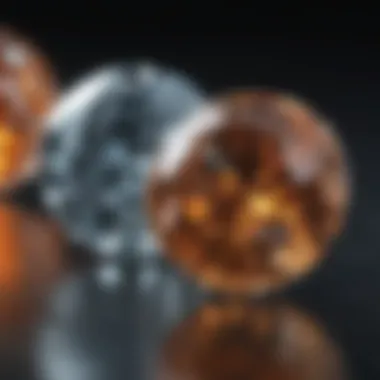
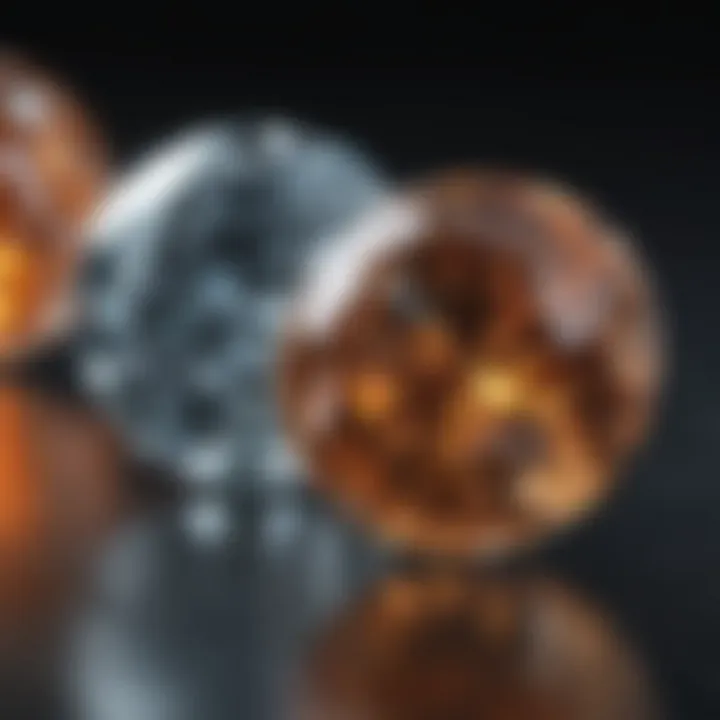
In summary, understanding synthetic diamonds and their clarity is vital for anyone looking to navigate the gemstone market. With evolving technologies and shifting public perspectives, synthetic diamonds offer compelling options worthy of consideration.
Common Misconceptions about Diamond Clarity
Understanding the various aspects of diamond clarity can significantly impact not just the buying experience but also the appreciation of these precious gems. Misconceptions surrounding diamond clarity may lead to misinformed decisions and unrealistic expectations. Tearing down these myths can illuminate the path to making more informed choices.
Misunderstanding Clarity Grades
One of the most prevalent misconceptions about diamond clarity lies in the understanding of clarity grades. Many individuals assume that a higher clarity grade automatically equates to a superior diamond. However, while clarity is indeed a crucial aspect of a diamond's quality, equating clarity alone with excellence oversimplifies the selection process.
In reality, clarity grades range from Flawless (FL) to Included (I), and each grade encapsulates specific characteristics. For instance, a diamond graded as VS2 may have tiny inclusions that are visible only under magnification, while one graded as SI1 may have inclusions that are somewhat easier to detect. This distinction is often lost on buyers, who may rush to judgment based solely on grade.
In addition to clarity grades, factors such as cut, color, and carat weight must also come into play. A diamond with a slightly lower clarity grade but superior cut can actually appear more beautiful than a flawless stone with poor cut. Thus, understanding the grading scale fosters a more nuanced view—not evaluating based solely on clarity.
Grade Interpretation Among Consumers
Another challenge arises in how clarity grades are interpreted by the general public. Many consumers lack familiarity with the intricacies of diamond grading, leading to confusion and varied interpretations. The jargon can sound like another language, often causing buyers to misinterpret what each grade really signifies. For example, when someone hears "VS" they may think it means the diamond is nearly perfect, not realizing that inferring quality from the abbreviation alone is misleading.
Moreover, the emotional value they attach to clarity might overshadow technical realities. When shopping for a significant piece of jewelry, personal sentiments can weigh heavily in decisions. Buyers might feel inclined to choose the higher clarity grade, driven by the perception of superiority, but fail to recognize that beauty can manifest in many forms.
"Understanding the nuances of clarity grades is as important as understanding the emotional significance of the diamond itself."
These misconceptions ultimately underline the need for education about diamond clarity. Being well-informed about the different grades and how they relate to beauty enhances appreciation. Additionally, buyers should give thought to their personal tastes and the attributes that matter most to them when selecting a diamond, rather than becoming fixated on clarity ratings alone.
By grasping nuances surrounding diamond clarity and acknowledging prevailing misconceptions, collectors, jewelers, and enthusiasts can cultivate a more profound appreciation for these intricate gems.
Clarity and Emotional Value
Diamond clarity holds a unique place in the conversation surrounding gemstones, influencing not just the technical grading but also emotional connections forged through these radiant stones. Clarity is often viewed through a lens of cold metrics: grades like Flawless or SI1. However, this narrative tends to overlook the deeply personal significance that a diamond's clarity can embody for its owner or giver.
Emotional resonance lies heavily in the stories we attach to these jewels. For many, a diamond is synonymous with love, commitment, and cherished memories. It is this emotional weight that elevates the concept of clarity beyond mere purity. Buyers may often find themselves gravitating towards imperfections that echo a personal journey or memory, illustrating how sentiment and emotion can influence their choices just as profoundly as technical specifications.
Personal Significance Over Technical Grades
When delving into the details of personal connections formed with diamonds, one begins to realize that clarity grades may not tell the whole tale. A Flawless diamond might dazzle the eye and where technical precision meets real-world implications is where clarity takes on an entirely new meaning.
It’s commonplace for individuals to disregard higher clarity grades in favor of stones that may have minor inclusions or blemishes. Why? Because those flaws often serve as tangible reminders of personal significance. Whether it's a diamond that once belonged to a beloved ancestor or one that was custom-chosen to mark a milestone, these gems transcend their technical qualities and become emblematic of life's moments.
Clarity as a Reflection of Sentiment
Clarity can also serve as a mirror reflecting an individual’s emotional values and experiences. Consider how deeply loved objects often come with stories that add texture to their existence. A diamond's clarity can offer a glimpse into the journey of its owner, revealing choices made in love, struggles encountered, and ultimately, triumphs celebrated.
"Ultimately, clarity isn’t just about how clear a diamond is. It’s about the clarity of the relationships, memories, and shared moments that it represents."
While some might value flawless clarity as the ideal, others embrace slight imperfections as testaments to their personal paths. The emotional significance can sometimes outweigh any benchmarks that the grading scales may propose.
As such, clarity becomes not only a critical factor in the evaluation of a diamond's worth but flourishing landscapes of sentiments intertwined in the fabric of its story. It morphs into an emotional touchstone for connections that transcend the metaphysical attributes of the stone, much like how we value the journeys of our loved ones against societal expectations.
In mastering the landscape between clarity and emotional value, one finds that diamonds are not just rocks; they symbolize enduring narratives that leave an imprint far extending beyond their surface brilliance.
Future Trends in Clarity Grading
As the diamond industry evolves, the concept of clarity grading is entering a new chapter, driven by innovative technology and changing consumer perceptions. Keeping abreast of these trends is essential for anyone who is invested in the world of diamonds, from collectors and jewelry designers to geology enthusiasts. Understanding future trends helps potential buyers and experts alike to navigate the complexities of diamond clarity with greater efficiency and insight.
Technological Advances in Diamond Evaluation
The tools and technology used to assess diamond clarity have come a long way over the past decade. No longer do gemologists rely solely on their eyes; today, automated systems equipped with high-resolution imaging and computer algorithms are changing the game.
- Laser Scanning: Advanced laser scanning can generate 3D models of diamonds, uncovering minute imperfections that might be missed by traditional methods.
- Spectroscopy: This technique allows for the analysis of diamonds at the molecular level, providing precise data not just about inclusions but also about their origins.
- Artificial Intelligence: AI systems are being trained to recognize clarity grades and detect inconsistencies in diamonds, making evaluations faster and more consistent.
These technological advancements not only improve the accuracy of grading but also enhance the transparency of the purchasing process. Shoppers can access digital evaluations and reports, gaining a clearer understanding of the diamond's clarity before making a purchase.
Shifting Norms in Clarity Appreciation
In recent years, attitudes towards diamond clarity are beginning to shift, reflecting broader changes in consumer preferences. It used to be that flawless diamonds were considered the ultimate ideal. However, many people now appreciate the unique stories behind inclusions and blemishes, viewing them as a form of individuality.
"Every imperfection tells a story; it's these small quirks that make each diamond unique."
The trend toward valuing character over perfection highlights several important aspects:
- Personalization: Buyers are increasingly searching for stones that resonate with their personal stories rather than conforming to idealized standards.
- Sustainability: With rising concerns over ethical sourcing, many individuals are leaning towards natural diamonds that carry inclusions as a form of legitimacy.
- Artistry: Jewelers are starting to embrace the beauty of clarity variations in their designs, allowing for more creative freedom.
As trends continue to develop, those who appreciate diamonds will need to keep an eye on both technological advancements and shifting consumer values to make informed choices about clarity grading.



